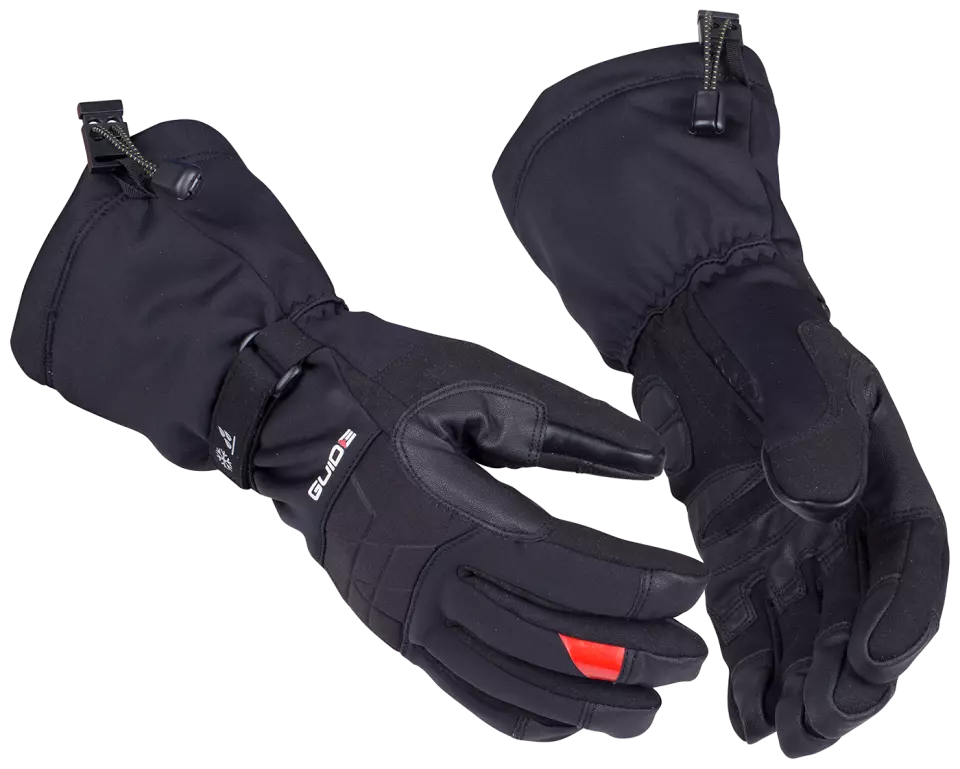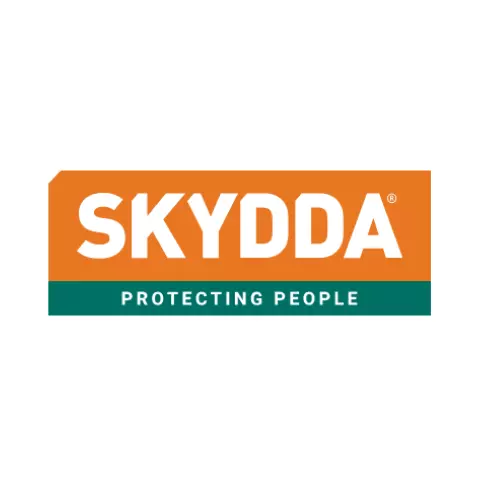Guide Waterproof Glove
Skydda
visit storeProduct description
Warm and waterproof work glove made of flexible material and designed for a good fit. The glove has a winter lining and a wind and waterproof membrane, which is attached in several places to keep it in place. The neoprene on the knuckles softens and protects against impact. Reinforcements in the palm make the glove resistant to wear and tear. Velcro straps on the wrist for a snug fit. The glove has an extra long cuff and an adjustable snow lock. The seams are carefully positioned to extend the life of the glove and provide better protection for the wearer. The glove has an ergonomic grip. The thumb has conductive fibres, which allows the touch control to be used without taking the gloves off. The glove is unobtrusive without reflective details. Suitable for buildings and other outdoor work, in cold and wet conditions. Protects down to -10°C. Reinforcements in abrasion resistant PU. Full lining, winter. Contoured fit. Touch screen function on thumb. Approvals: EN 388 2221 X, EN 511 12 X
The exterior color of the gloves, which can aid in workplace identification, visibility, and compliance with safety protocols.
Seamlessly interact with touch screens, maintaining protection and efficiency on the job.
Full finger coverage provides complete protection for all your digits, ensuring maximum safety.
Versatile design for a wide range of tasks, giving you reliable protection and flexibility for diverse jobs.
The inner layer or coating that affects comfort, ease of putting on gloves, moisture control, and warmth during wear.
Determines how the glove secures around the wrist, affecting fit, comfort, and protection coverage at the wrist area.
- Cut Resistant
- Water Resistance
- Cold Protective
- Slip Resistant
- Impact Resistance
Request a free sample
Test first and buy later. Visit any product page to request your free sample.
Standards and labels
EN 511:2006 is a European standard that sets requirements for the protection against cold for gloves and mittens. It covers factors such as resistance to cold, water penetration and breathability. Testing must be done by a certified lab and must show that the product meets all requirements of the standard. Possible test results would include pass/fail for each requirement, as well as specific measurement data.
Test results
Convective Cold Level 1The standard EN 511:2006 specifies requirements and test methods for gloves designed to protect against cold environments, focusing on elements such as convective cold, contact cold, and water permeability. The Convective Cold test, particularly at Level 1, results in a performance level where the thermal insulation (denoted as TR) measured in \(m^2°C/W\) is in the range of 0.10 to less than 0.15. This measurement indicates the glove's ability to provide minimal thermal resistance against cold air. The Convective Cold Test involves placing a glove on an electrically heated hand model, where the power required to maintain the hand at a set temperature (typically around 30°C) in a controlled cooling environment is measured. The glove's performance level is determined based on how much power is needed to keep the hand warm as the surrounding temperature decreases. Level 1 highlights a basic level of insulation against cold air, suitable for environments where slight cold protection is sufficient, but would not be suitable for more severe cold conditions. .
Cold Contact Level 2The standard EN 511:2006 specifies requirements for protective gloves that guard against cold environments. Cold Contact result Level 2 indicates moderate insulation against contact cold, quantified with a thermal resistance measurement in the range of 0.050 to less than 0.100 m²°C/W. This means gloves achieving this level can provide a reasonable amount of insulation, helping to reduce heat transfer from the hands to the cold contact surface, thereby lowering the rate at which hands become cold. The measurement of contact cold resistance is performed using a standardized test that involves placing the glove materials against metal plates cooled to different temperatures. The difference in temperature across the glove material is then analyzed to determine its thermal resistance. For practical implications, gloves classified under Level 2 of Cold Contact in EN 511:2006 are suitable for environments or tasks where individuals are exposed to cold objects but do not necessarily involve extreme cold or extended exposure, offering a balance between dexterity and protection from the cold .
Water Tightness Level XThe standard EN 511:2006 defines the requirements for protective gloves against cold. The reference to a Water Tightness Level X in this standard typically indicates that the glove has not been tested for water tightness. Water tightness is assessed through a specific test method where the gloves are subjected to water exposure under controlled conditions to check for leakage. The gloves are filled with water and then inspected visually to determine the presence of any water leakage. The practical implications of a Level X result for water tightness suggest that the gloves are either not designed to be waterproof or they failed to meet the minimum criteria for being labeled as water-resistant under normal usage conditions. This information is important for procurement professionals focusing specifically on the need for water-resistant or waterproof protective gloves.
EN 388:2016 is a European standard for measuring the performance of protective gloves against mechanical risks (abrasion, cut, tear, and puncture). The standard includes test methods and performance requirements for gloves to be considered compliant. Test results are reported using a series of four numbers, each representing the performance level achieved in one of the tests.
Test results
Puncture Resistance Level 2The standard EN 388:2016 includes an assessment of Puncture Resistance, where Level 2 signifies that the material has met specific criteria for resistance against puncture. The result of Level 2 in puncture resistance means that the protective glove or material can withstand a force of 60 to 100 newtons before being punctured. The test method used involves using a standardized steel puncture probe that is pushed against the material at a specified speed until it pierces through it. In essence, achieving a Level 2 puncture resistance under EN 388:2006 suggests that the protective equipment offers moderate protection against punctures, making it suitable for environments where there is a risk of encountering sharp objects such as needles, but are not excessively sharp or exert very high force.
Cut Resistance, ISO 13997 Level XThe standard EN 388:2016, specifically its segment referring to ISO 13997 test, is designed to assess the cut resistance of materials used in protective gloves. A result denoted as 'Level X' means that test is not performed and the cut resistance of the product cannot be guaranteed.
Cut Resistance, Coup Test Level 2EN 388:2016 standard features a Coup Test used to measure Cut Resistance, and a result of Level 2 indicates moderate protection against cuts. This level signifies that the material being tested withstood between 2.5 to 5.0 cutting cycles before the blade penetrated the glove during testing. The Coup Test involves a rotating circular blade with a constant force applied, moving back and forth across the material until a cut through occurs. The sharpness of the blade and the distance of blade travel are measured before the test, and after cutting through the material, to ensure accuracy. Practical implications of a Level 2 result suggest the gloves are suitable for tasks with some cut hazards but are not suggested for high-risk cut environments, such as handling heavy or very sharp materials where a higher level of protection might be necessary. This result helps businesses choose gloves tailored for different workplace needs regarding cut risks.
Abrasion Resistance Level 2EN 388:2016 is an updated European standard that specifies criteria for testing gloves to protect against mechanical risks, including abrasion, cuts, tears, and puncture. The Abrasion Resistance Level 2 classification within this standard indicates a moderate level of protection against wear from rough materials. The abrasion resistance test involves subjecting the glove material to repeated cycles of sandpaper under pressure until the material wears through. Level 2 abrasion resistance means the gloves can withstand between 500 to 1999 cycles before being penetrated. This level of protection is suitable for tasks that involve handling or coming into contact with abrasive materials but not at an extreme or heavy-duty level. Gloves with Level 2 abrasion resistance are well-suited for general handling tasks, offering durability and protection to extend the life of the glove while maintaining good dexterity and comfort.
Tear Resistance Level 2EN 388:2016 is a European standard that sets criteria for testing the mechanical risks for protective gloves, including abrasion, cut, tear, and puncture resistance. The Tear Resistance Level 2 designation indicates that the gloves have a moderate level of resistance to tearing. The test for tear resistance involves subjecting a sample of the glove material to a force until it tears, and the force required to initiate and propagate the tear is measured. Gloves that achieve Level 2 tear resistance can withstand between 25 to 50 Newtons of force. This level of tear resistance is suitable for tasks where gloves might face moderate stresses that could cause tearing, such as general handling and light industrial work where sharp or jagged materials are handled less frequently. These gloves provide reliable protection and durability in scenarios where some degree of mechanical risk is present but not excessively severe.
CE Marking is a label that shows a product meets certain safety and environmental standards set by the European Union. To get the CE Marking, a company must test and certify their product meets these standards. CE Marking is required for many products sold in the EU, including electronics, machinery, toys and medical devices. It helps ensure that products are safe for consumers and the environment, and allows for easy trade within the EU.
PPE stands for "personal protective equipment." PPE Category 2 refers to equipment that is more complex, and has a higher level of risk. Examples of PPE Category 2 include safety helmets, ear protection, and fall arrest equipment. In Europe, PPE Category 2 must meet certain safety standards set by the European Union, which means that it must be designed and manufactured to protect the user without causing harm. Companies that make or sell PPE must prove that it meets these standards. They also must have a quality management system in place and have to be audited regularly by a notified body.
Skydda delivery terms
Free delivery when you order more than 1 650,00 kr from Skydda
Supplier shipping fee 60,00 kr
Brand minimum 0,00 kr
1 266,18 kr
Price per 3 pairs
422,06 kr / pair
Shipping fee is 60,00 kr for orders under 1 650,00 kr
A package contains 3 pairs
Need larger quantities?
Other products you may like
Recently viewed
Need help?
Get help from our experts
Other products you may like
Similar products you may like
Autonomous sourcing platform
The most efficient way to source and order supplies for your operations
Sourcing
Ordering
List products you’re looking for and we’ll find the best products and prices for you – all for free.
Need help?
Get help from our experts



